Deck 1: Introduction: What Is Biomedical Engineering
سؤال
سؤال
سؤال
سؤال
سؤال
سؤال
سؤال
سؤال
سؤال
سؤال

فتح الحزمة
قم بالتسجيل لفتح البطاقات في هذه المجموعة!
Unlock Deck
Unlock Deck
1/10
العب
ملء الشاشة (f)
Deck 1: Introduction: What Is Biomedical Engineering
1
Figure 1.14 shows a mechanical artificial heart valve. If this valve opens and closes once during each cycle, or beat, of the heart, how many times will the valve need to open and close during 10 years of continuous use? Measure your own heart rate (describe how you do it) and use this rate in answering this question. 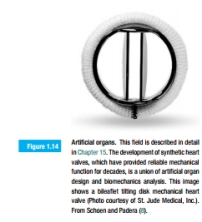

The mechanical artificial heart valve is a device implanted in the heart of patients affected with diseased heart valves. Valves are integral part of heart; they evolved to perform the unidirectional flow of blood from one chamber to another chamber of heart. The natural heart valves may become dysfunctional for a variety of reasons; these conditions may require complete replacement of valves with an artificial heart valve. 





2
Figure 1.15 shows an image of a microscope slide, onto which small spots of protein have been printed. The slide was used to identify protein compositions that provide for good adhesion of cells. If each spot of protein is 300 microns (micrometers) in diameter, and each cell is 15 microns in diameter, what is the maximum number of cells that can fit into each spot? 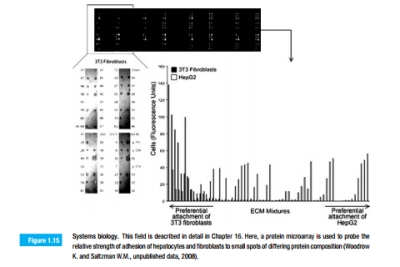

The maximum number of cells that fit into each spot of protein with the diameter 300 microns can be calculated by the following calculation :  So, the maximum number of
So, the maximum number of  can fit into each spot.
can fit into each spot.
 So, the maximum number of
So, the maximum number of  can fit into each spot.
can fit into each spot. 3
Drugs are often administered in capsules. Some capsules act as containers, which hold many smaller particles that contain the active agent. Administra- tion of the drug is improved by the capsule; when the capsule breaks down in the intestine and the particles are freed from the container, the large surface area of the drug particles allows rapid dissolution of the drug.
a. Assume that a capsule is approximately 1 cm long and 3 mm in diameter. Calculate the surface-to-volume ratio of the capsule.
b. Assume that the capsule is filled with particles that are 0.4 mm in diameter. How many of these particles will fit into one capsule?
c. What is the total surface area of the particles within the capsule?
a. Assume that a capsule is approximately 1 cm long and 3 mm in diameter. Calculate the surface-to-volume ratio of the capsule.
b. Assume that the capsule is filled with particles that are 0.4 mm in diameter. How many of these particles will fit into one capsule?
c. What is the total surface area of the particles within the capsule?
Capsules are used to administrate drugs, they act as containers. When a capsule breaks down in the intestine, they release drug particles thus allows rapid dissolution of the drug.
a) Surface to volume ratio of the capsule can be calculated from the given information as follows:

 Surface area to volume ratio of the capsule is:
Surface area to volume ratio of the capsule is:  b) The number of capsules with the diameter of 0.4 mm fit into one capsule can be determined by the below calculation:
b) The number of capsules with the diameter of 0.4 mm fit into one capsule can be determined by the below calculation: 
 So,
So,  of particles fit into one capsule
of particles fit into one capsule
c) The total surface area of the particles within the capsule can be calculated by using the below formula:

a) Surface to volume ratio of the capsule can be calculated from the given information as follows:


 Surface area to volume ratio of the capsule is:
Surface area to volume ratio of the capsule is:  b) The number of capsules with the diameter of 0.4 mm fit into one capsule can be determined by the below calculation:
b) The number of capsules with the diameter of 0.4 mm fit into one capsule can be determined by the below calculation: 
 So,
So,  of particles fit into one capsule
of particles fit into one capsulec) The total surface area of the particles within the capsule can be calculated by using the below formula:


4
Write a definition (1-2 sentences) of biomedical engineering in your own words (test yourself by not looking back at any of the definitions in the text when you write your own definition).

فتح الحزمة
افتح القفل للوصول البطاقات البالغ عددها 10 في هذه المجموعة.
فتح الحزمة
k this deck
5
Using only the information provided in Figure 1.1, estimate the following: 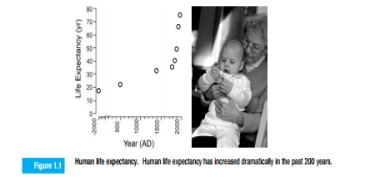
a. Human life expectancy in the year 1250.
b. Human life expectancy in the year 2050.

a. Human life expectancy in the year 1250.
b. Human life expectancy in the year 2050.

فتح الحزمة
افتح القفل للوصول البطاقات البالغ عددها 10 في هذه المجموعة.
فتح الحزمة
k this deck
6
Make two lists (of at least 10 items each) in response to the following two questions: a. What products of biomedical engineering have you personally encoun- tered? Pick three of these products and write a description of what you think is good, and what could be improved in that product. b. What products of biomedical engineering do you expect to encounter in the next 50 years?

فتح الحزمة
افتح القفل للوصول البطاقات البالغ عددها 10 في هذه المجموعة.
فتح الحزمة
k this deck
7
From Figure 1.8, estimate the fraction of biomedical engineering students who were undergraduates in 1980, 1985, 1990, 1995, and 2000. 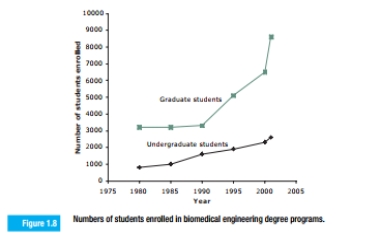


فتح الحزمة
افتح القفل للوصول البطاقات البالغ عددها 10 في هذه المجموعة.
فتح الحزمة
k this deck
8
Pick a faculty member who teaches or does research in biomedical engineer- ing from your department for this exercise.
a. Perform a Medline search with your selected faculty member as the author to find a list of articles that he or she has written in the past two years.
b. Select one of the articles and find a copy of it in your library (or online if it is available in that format). Read it and write a brief review of the findings for a general audience. In which subdiscipline of biomedical engineering does this research work belong?
a. Perform a Medline search with your selected faculty member as the author to find a list of articles that he or she has written in the past two years.
b. Select one of the articles and find a copy of it in your library (or online if it is available in that format). Read it and write a brief review of the findings for a general audience. In which subdiscipline of biomedical engineering does this research work belong?

فتح الحزمة
افتح القفل للوصول البطاقات البالغ عددها 10 في هذه المجموعة.
فتح الحزمة
k this deck
9
Figure 1.13 shows a surgeon holding a GLIADEL?R wafer. From this photo- graphic evidence only, estimate the following: 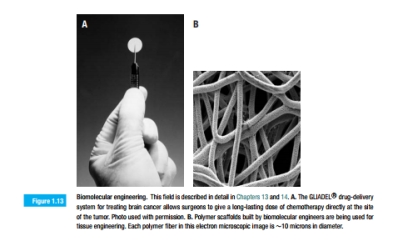
a. The dimensions of the wafer.
b. The dose of drug that it contains, if the loading of drug is 3.85% by mass (i.e., 3.85% of the wafer mass is due to the drug).

a. The dimensions of the wafer.
b. The dose of drug that it contains, if the loading of drug is 3.85% by mass (i.e., 3.85% of the wafer mass is due to the drug).

فتح الحزمة
افتح القفل للوصول البطاقات البالغ عددها 10 في هذه المجموعة.
فتح الحزمة
k this deck
10
Interview an older family member (parent, grandparent, aunt, uncle) about an advance in medicine that they remember. Why was this advance memorable to them? How did they find out about it?

فتح الحزمة
افتح القفل للوصول البطاقات البالغ عددها 10 في هذه المجموعة.
فتح الحزمة
k this deck








